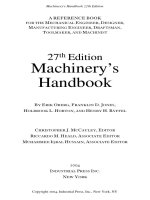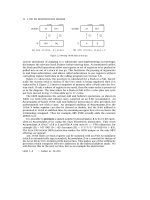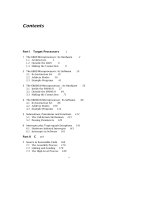Heat Transfer Applications for the Practicing Engineer potx
Bạn đang xem bản rút gọn của tài liệu. Xem và tải ngay bản đầy đủ của tài liệu tại đây (2.65 MB, 664 trang )
Heat Transfer Applications for the
Practicing Engineer
Heat Transfer
Applications for the
Practicing Engineer
Louis Theodore
Copyright # 2011 by John Wiley & Sons, Inc. All rights reserved
Published by John Wiley & Sons, Inc., Hoboken, New Jersey
Published simultaneously in Canada
No part of this publication may be reproduced, stored in a retrieval system, or transmitted in any form
or by any means, electronic, mechanical, photocopying, recording, scanning, or otherwise, except as
permitted under Section 107 or 108 of the 1976 United States Copyright Act, without either the prior
written permission of the Publisher, or authorization through payment of the appropriate per-copy fee to
the Copyright Clearance Center, Inc., 222 Rosewood Drive, Danvers, MA 01923, (978) 750-8400, fax
(978) 750-4470, or on the web at www.copyright.com. Requests to the Publisher for permission should
be addressed to the Permissions Department, John Wiley & Sons, Inc., 111 River Street, Hoboken, NJ
07030, (201) 748-6011, fax (201) 748-6008, or online at />Limit of Liability/Disclaimer of Warranty: While the publisher and author have used their best efforts in
preparing this book, they make no representations or warranties with respect to the accuracy or completeness
of the contents of this book and specifically disclaim any implied warranties of merchantability or fitness for
a particular purpose. No warranty may be created or extended by sales representatives or written sales
materials. The advice and strategies contained herein may not be suitable for your situation. You should
consult with a professional where appropriate. Neither the publisher nor author shall be liable for any loss of
profit or any other commercial damages, including but not limited to special, incidental, consequential, or
other damages.
For general information on our other products and services or for technical support, please contact our
Customer Care Department within the United States at (800) 762-2974, outside the United States at
(317) 572-3993 or fax (317) 572-4002.
Wiley also publishes its books in a variety of electronic formats. Some content that appears in print may
not be available in electronic formats. For more information about Wiley products, visit our web site at
www.wiley.com.
Library of Congress Cataloging-in-Publication Data:
Theodore, Louis.
Heat transfer applications for the practicing engineer/Louis Theodore.
p. cm. - - (Essential engineering calculations series; 4)
Includes index.
ISBN 978-0-470-64372-3 (hardback)
1. Heat exchangers. 2. Heat Transmission. I. Title.
TJ263.T46 2011
621.402
0
2- -dc23
2011016265
Printed in the United States of America
oBook ISBN: 9780470937228
ePDF ISBN: 9780470937211
ePub ISBN: 9781118002100
10987654321
To
Jack Powers
My friend,
a future basketball Hall-of-Famer,
and
a true quality individual
Contents
Preface xv
Introductory Comments xvii
Part One Introduction
1. History of Heat Transfer
3
Introduction 3
Peripheral Equipment 4
Recent History 5
References 6
2. History of Chemical Engineering: Transport Phenomena
vs Unit Operations
7
Introduction 7
History of Chemical Engineering 8
Transport Phenomena vs Unit Operations 10
What is Engineering? 12
References 13
3. Process Variables 15
Introduction 15
Units and Dimensional Consistency 16
Key Terms and Definitions 19
Fluids 19
Temperature 19
Pressure 20
Moles and Molecular Weights 22
Mass and Volume 23
Viscosity 25
Heat Capacity 27
Thermal Conductivity 28
Thermal Diffusivity 30
Reynolds Number 30
vii
Kinetic Energy 31
Potential Energy 32
Determination of Dimensionless Groups 33
References 36
4. Conservation Laws 37
Introduction 37
The Conservation Laws 38
The Conservation Law for Momentum 38
The Conservation Law for Mass 40
The Conservation Law for Energy 45
References 54
5. Gas Laws 55
Introduction 55
Boyle’s and Charles’ Laws 56
The Ideal Gas Law 57
Standard Conditions 60
Partial Pressure and Partial Volume 63
Non-Ideal Gas Behavior 65
References 65
6. Heat Exchanger Pipes and Tubes 67
Introduction 67
Pipes 67
Tubes 73
Valves and Fittings 75
Valves 75
Fittings 77
Noncircular Conduits 78
Flow Considerations 80
References 83
Part Two Principles
7. Steady-State Heat Conduction
87
Introduction 87
Fourier’s Law 87
Conductivity Resistances 90
Microscopic Approach 99
viii Contents
Applications 102
References 114
8. Unsteady-State Heat Conduction 115
Introduction 115
Classification of Unsteady-State Heat Conduction Processes 116
Microscopic Equations 117
Applications 118
References 130
9. Forced Convection 131
Introduction 131
Convective Resistances 134
Heat Transfer Coefficients: Qualitative Information 137
Heat Transfer Coefficients: Quantitative Information 138
Flow Past a Flat Plate 141
Flow in a Circular Tube 146
Liquid Metal Flow in a Circular Tube 147
Convection Across Cylinders 148
Microscopic Approach 155
References 159
10. Free Convection 161
Introduction 161
Key Dimensionless Numbers 162
Describing Equations 164
Environmental Applications 171
Lapse Rates 171
Plume Rise 173
References 176
11. Radiation 177
Introduction 177
Energy and Intensity 180
Radiant Exchange 183
Kirchoff’s Law 184
Emissivity Factors 189
View Factors 196
References 200
Contents
ix
12. Condensation and Boiling 201
Introduction 201
Condensation Fundamentals 203
Phase Equilibrium 205
Psychrometric Chart 207
Steam Tables 208
Condensation Principles 209
Boiling Fundamentals 215
Boiling Principles 218
References 225
13. Refrigeration and Cryogenics 227
Introduction 227
Background Material 228
Refrigeration 228
Cryogenics 230
Liquefaction 231
Cryogens 232
Equipment 234
Typical Heat Exchangers 234
Materials of Construction 235
Insulation and Heat Loss 236
Storage and Transportation 240
Hazards, Risks, and Safety 241
Physiological Hazards 241
Physical Hazards 242
Chemical Hazards 244
Basic Principles and Applications 244
Coefficient of Performance 246
Thermal Efficiency 248
Entropy and Heat 252
References 253
Part Three Heat Transfer Equipment Design Procedures and Applications
14. Introduction to Heat Exchangers
257
Introduction 257
Energy Relationships 258
Heat Exchange Equipment Classification 260
x Contents
The Log Mean Temperature Difference (LMTD) Driving Force 262
Temperature Profiles 265
Overall Heat Transfer Coefficients 268
Fouling Factors 271
The Controlling Resistance 272
Varying Overall Heat Transfer Coefficients 276
The Heat Transfer Equation 278
References 279
15. Double Pipe Heat Exchangers 281
Introduction 281
Equipment Description 282
Describing Equations 286
Calculation of Exit Temperatures 298
Effectiveness Factor and Number of Transfer Units 304
Wilson’s Method 309
References 313
16. Shell and Tube Heat Exchangers 315
Introduction 315
Equipment Description 316
Describing Equations 322
The “F” Factor 328
Effectiveness Factor and Number of Transfer Units 344
References 356
17. Fins and Extended Surfaces 357
Introduction 357
Fin Types 358
Describing Equations 360
Fin Effectiveness and Performance 371
Fin Considerations 380
References 380
18. Other Heat Exchange Equipment 381
Introduction 381
Evaporators 382
Mixing Effects 384
Waste Heat Boilers 392
Describing Equations 394
Contents
xi
Condensers 401
Quenchers 404
Dilution with Ambient Air 405
Quenching with Liquids 405
Contact with High Heat Capacity Solids 405
Natural Convection and Radiation 406
Forced-Draft Cooling 406
References 410
19. Insulation and Refractory 411
Introduction 411
Describing Equations 411
Insulation 430
Critical Insulation Thickness 431
Refractory 435
References 442
20. Operation, Maintenance, and Inspection (OM&I) 443
Introduction 443
Installation Procedures 443
Clearance Provisions 444
Foundations 444
Leveling 444
Piping Considerations 444
Operation 445
Startup 446
Shut Down 446
Maintenance and Inspection 446
Cleaning 446
Testing 447
Improving Operation and Performance 448
References 449
21. Entropy Considerations and Analysis 451
Introduction 451
Qualitative Review of the Second Law 452
Describing Equations 453
The Heat Exchanger Dilemma 455
Applications 460
References 463
22. Design Principles and Industrial Applications 465
Introduction 465
xii Contents
General De sign Procedures 466
Process Schematics 467
Purchasing a Heat Exchanger 468
Applications 470
References 490
Part Four Special Topics
23. Environmental Man agement
493
Introduction 493
Environmental Management History 493
Environmental Management Topics 495
Applications 496
References 503
24. Accident and Emergency Management 505
Introduction 505
Legislation 506
Comprehensive Environmental Response, Compensation, and
Liability Act (CERCLA) 506
Superfund Amendments and Reauthorization Act of 1986 (SARA) 507
Occupational Safety and Health Act (OSHA) 508
USEPA’s Risk Management Program (RMP) 509
Hazard Risk Assessment 510
Applications 513
References 531
25. Ethics 533
Introduction 533
Teaching Ethics 534
The Case Study Approach 535
Applications 537
References 540
26. Numerical Methods 541
Introduction 541
History 542
Partial Differential Equations (PDE) 544
Parabolic PDE 545
Elliptical PDE 546
Regresion Analysis 554
Correlation Coefficient 557
Contents
xiii
Optimization 560
Perturbation Studies in Optimization 560
References 562
27. Economics and Finance 563
Introduction 563
The Need for Economic Analyses 563
Definitions 565
Simple Interest 565
Compound Interest 565
Present Worth 566
Evaluation of Sums of Money 566
Depreciation 567
Fabricated Equipment Cost Index 567
Capital Recovery Factor 567
Present Net Worth 568
Perpetual Life 568
Break-Even Point 569
Approximate Rate of Return 569
Exact Rate of Return 569
Bonds 570
Incremental Cost 570
Optimization 570
Principles of Accounting 571
Applications 573
References 588
28. Open-Ended Problems 589
Introduction 589
Developing Students’ Power of Critical Thinking 592
Creativity 592
Brainstorming 593
Inquiring Minds 594
Applications 594
References 602
Appendix A. Units 603
Appendix B. Tables 613
Appendix C. Figures 627
Appendix D. Steam Tables 631
Index 639
xiv Contents
Preface
W
e should be careful to get out of an experience only the wisdom that is in it—and
stop there; lest we be like the cat th at sits down on a hot stove-lid. She will never
sit down on a hot stove-lid again—and that is well; but also she will never sit down on a
cold one anymore.
Mark Twain (Samuel Langhorne Clemens 1835 –1910),
Pudd’nhead Wilson, Chapter 19
This project was a rather unique undertaking. Heat transfer is one of the three
basic tenants of chemical engineering and engineering science, and contains many
basic and practical concepts that are utilized in countless industrial applications.
The author therefore considered writing a practical text. The text would hopefully
serve as a training tool for those individuals in industry and academia involved
directly, or indirectly, with heat transfer applications. Although the literature is
inundated with texts emphasizing theory and theoretical derivations, the goal of this
text is to present the subject of heat transfer from a strictly pragmatic point-of-view.
The book is divided into four Parts: Introduction, Principles, Equipment Design
Procedures and Applications, and ABET-related Topics. The first Part provides a
series of chapters concerned with introductory topics that are required when solving
most engineering problems, including those in heat transfer. The second Part of the
book is concerned with heat transfer principles. Topics that receive treatment include
steady-state heat conduction, unsteady-state heat conduction, forced convection, free
convection, radiation, boiling and cond ensation, and cryogenics. Part Three—
considered by the author to be the “meat” of the book—addresses heat transfer equip-
ment design procedures and applications. In addition to providing a detailed treatment
of the various types of heat exchangers, this part also examines the impact of entropy
calculations on exchanger design, operation, maintenance and inspection (OM&I),
plus refractory and insulation effects. The concluding Part of the text examines
ABET (Accreditation Board for Engineering and Technology)-related topics of con-
cern, including environmental management, safety and accident management, ethics,
numerical methods, economics and finance, and open-ended problems. An appendix
is also included. An outline of the topics covered can be found in the Table of
Contents.
The author cannot claim sole authorship to all of the problems and material in this
text. The present book has evolved from a host of sources, including: notes, homework
problems and exam problems prepared by several faculty for a required one-semester,
three-credit, “Principles II: Heat Transfer” undergraduate course offered at Manhattan
College; I. Farag and J. Reynolds, “Heat Transfer”, A Theodore Tutorial, East
Williston, N.Y., 1994; J. Reynolds, J. Jeris, and L. Theodore, “Handbook of
xv
Chemical and Environmental Engineering Calculations”, John Wiley & Sons 2004,
and J. Santoleri, J. Reynolds, and L. Theodore’s “Introduction to Hazardous Waste
Incineration”, 2nd edition, John Wiley & Sons, 2000. Although the bulk of the pro-
blems are original and/or taken from sources that the author has been directly
involved with, every effort has been made to acknowledge material drawn from
other sources.
It is hoped that this writing will place in the hands of industrial, academic, and
government personnel, a book covering the principles and applications of heat transfer
in a thorough and clear manner. Upon completion of the text, the reader should have
acquired not only a working knowledge of the principles of heat transfer operations,
but also experience in their application; and, the reader should find himself/herself
approaching advanced texts, engineering literature, and industrial applications (even
unique ones) with more confidence. The author strongly believes that, while under-
standing the basic concepts is of paramount importance, this knowledge may be
rendered virtually useless to an engineer if he/she cannot apply these concepts to
real-world situations. This is the essence of engineering.
Last, but not least, I believe that this modest work will help the majority of indi-
viduals working and/or studying in the field of engineering to obtain a more complete
understanding of heat transfer. If you have come this far, and read through most of the
Preface, you have more than just a passing interest in this subject. I strongly suggest
that you try this text; I think you will like it.
My sincere thanks are extended to Dr. Jerry Maffia and Karen Tschinkel at
Manhattan College for their help in solving some of the problems and proofing the
manuscript, and to the ever reliable Shannon O’Brien for her valuable assistance.
L
OUIS THEODORE
xvi Preface
Introductory Comments
P
rior to undertaking the writing of this text, the author (recently) co-authored a text
entitled “Thermodynamics for the Practicing Engineer”. It soon became apparent
that some overlap existed between thermodynamic and heat transfer (the subject of
this text). Even though the former topic is broadly viewed as a science, heat transfer
is one of the unit operations and can justifiably be classified as an engineering subject.
But what are the similarities and what are the differences?
The similarities that exist between thermodynamics and heat transfer are
grounded in the three conservation laws: mass, energy, and momentum. Both are pri-
marily concerned with energy-related subject matter and both, in a very real sense,
supplement each other. However, thermodynamics deals with the transfer of energy
and the conversion of energy into other forms of energy (e.g., heat into work), with
consideration generally limited to systems in equilibrium. The topic of heat transfer
deals with the transfer of energy in the form of heat; the applications almost exclu-
sively occur with heat exchangers that are employed in the chemical, petrochemical,
petroleum (refinery), and engineering processes.
The aforementioned transfer of heat occurs between a hot and a cold body, nor-
mally referred to as the source and receiver, respectively. (The only exception is in
cryogenic applications.) When this transfer occurs in a heat exchanger, some or all
of the following 10 topics/subjects can come into play:
1. The class of heat exchanger
2. The physical surface arrangement of the exchanger
3. The quantity or rate of heat transferred
4. The quantity or rate of heat “lost” in the application
5. The temperature difference between the source and receiver
6. The prime mover(s) required in the application (e.g., pump, fan, etc.)
7. The entropy gain (i.e., the quality energy lost in the application)
8. The cost to design, construct, and start up a new application
9. The cost to operate the exchanger
10. The cost to maintain the exchanger
Each of the above topics receive treatment once or several times in this text.
xvii
Part One
Introduction
Part One serves as the introductory section to this book. It reviews engineering and
science fundamentals that are an integral part of the field of heat transfer. It consists
of six chapters, as noted below:
1. History of Heat Transfer
2. History of Chemical Engineering: Transport Phenomena vs Unit Operations
3. Process Variables
4. Conservation Laws
5. Gas Laws
6. Heat Exchanger Pipes and Tubes
Those individuals with a strong background in the above area(s) may choose to bypass
all or some of this Part.
1
Chapter 1
History of Heat Transfer
Ã
INTRODUCTION
After a review of the literature, the author has concluded that the concept of heat
transfer was first introduced by the English scientist Sir Isaac Newton in his 1701
paper entitled “Scala Graduum Caloris.”
(1)
The specific ideas of heat convection and
Newton’s Law of Cooling were developed from that paper.
Before the development of kinetic theory in the middle of the 19th century, the
transfer of heat was explained by the “caloric” theory. This theory was introduced
by the French chemist Antoine Lavoisier (1743–1794) in 1789. In his paper,
Lavoisier proposed that caloric was a tasteless, odorless, massless, and colorless
substance that could be transferred from one body to another and that the transfer of
caloric to a body increased the temperature, and the loss of calorics correspondingly
decreased the temperature. Lavoisier also stated that if a body cannot absorb/accept
any additional caloric, then it should be considered saturated and, hence, the id ea of
a saturated liquid and vapor was developed.
(2)
Lavoisier’s caloric theory was never fully accepted because the theory essentially
stated that heat could not be created or destroyed, even though it was well known that
heat could be generated by the simple act of rubbing hands together. In 1798, an
American physicist, Benjamin Thompson (1753–1814), reported in his paper that
heat was generated by friction, a form of motion, and not by caloric flow. Although
his idea was also not readily accepted, it did help establish the law of conservation
of energy in the 19th century.
(3)
In 1843, the caloric theory was proven wrong by the English physicist James P.
Joule (1818–1889). His experiments provided the relationship between mechanical
work and the nature of heat, and led to the development of the first law of thermodyn-
amics of the conservation of energy.
(4)
The development of kinetic theory in the 19th century put to rest all other theories.
Kinetic theory states that energy or heat is created by the random motion of atoms and
molecules. The introduction of kinetic theory helped to develop the concept of the
conduction of heat.
(5)
Ã
Part of this chapter was adapted from a report submitted by S. Avais to L. Theodore in 2007.
Heat Transfer Applications for the Practicing Engineer. Louis Theodore
# 2011 John Wiley & Sons, Inc. Published 2011 by John Wiley & Sons, Inc.
3
The earlier developments in heat transfer helped set the stage for the French
mathematician and physicist Joseph Fourier (1768–1830) to reconcile Newton’s
Law of Cooling, which in turn led to the development of Fourier’s Law of
Conduction. Newton’s Law of Cooling suggested that there was a relationship
between the temperature difference and the amount of heat transferred. Fourier
took Newton’s Law of Cooling and arrived at a convection heat equation.
(6)
Fourier also developed the concepts of heat flux and temperature gradient. Using
the same process as he used to develop the equation of heat convection, Fourier sub-
sequently developed the classic equation for heat conduction that has come to be
defined as Fourier’s law.
(7)
Two additional sections complement the historical contents of this chapter.
These are:
Peripheral Equipment
Recent History
PERIPHERAL EQUIPMENT
With respect to heat transfer equipment, the bulk of early equipment involved the
transfer of heat across pipes. The history of pipes dates back to the Roman Empire.
The ingenious “engineers” of that time came up with a solution to supply the
never-ending demand of a city for fresh water and then for disposing of the waste-
water produced. Their system was based on pipes made out of wood and stone, and
the driving force of the water was gravity.
(8)
Over time, many improvements have
been made to the piping system. These improvements include material choice,
shape, and size of the pipes: pipes are now made from different metals, plastic, and
even glass, with different diameters and wall thicknesses. The next challenge was
the connection of the pipes and that was accomplished with fittings. Changes in
piping design ultimately resulted from the evolving industrial demands for specific
heat transfer requirements and the properties of fluids that needed to be heated
or cooled.
(9)
The movement of the fluids to be heated or cooled was accomplished with prime
movers, particularly pumps. The first pump can be traced back to 3000
B.C., in
Mesopotamia, where it was used to supply water to the crops in the Nile River
Valley.
(10)
The pump was a long lever with a weight on one side and a bucket on
the other. The use of this first pump became popular in the Middle East and was
used for the next 2000 years. At times, a series of pumps would be put in place to pro-
vide a constant flow of water to crops far from the source. The most famous of these
early pumps is the Archimedean screw. The pump was invented by the famous Greek
mathematician and inventor Archimedes (287 –212
B.C.). The pump was made of a
metal pipe in which a helix-shaped screw was used to draw water upward as the
screw turned. Modern force pumps were adapted from an ancient pump that featured
a cylinder with a piston “at the top that create[d] a vacuum and [drew] water
4 Chapter 1 History of Heat Transfer
upward.”
(10)
The first force pump was designed by Ctesibus (285–222 B.C.) of
Alexandria, Egypt. Leonardo Da Vinci (1452–1519) was the first to come up with
the idea of lifting water by means of centrifugal force; however, the operation of
the centrifugal pump was first described scientifically by the French physicist Denis
Papin (1647–1714) in 1687.
(11)
In 1754, Leonhard Euler further developed the prin-
ciples on which centrifugal pumps operated; today, the ideal pump performance term,
“Euler head,” is named after him.
(12)
RECENT HISTORY
Heat transfer, as an engineering practice, grew out of thermodynamics at around the
turn of the 20th century. This arose because of the need to deal with the design of
heat transfer equipment required by emerging and growing industries. Early appli-
cations included steam generators for locomotives and ships, and condensers for
power generation plants. Later, the rapidly developing petroleum and petrochemical
industries began to require rugged, large-scale heat exchangers for a variety of pro-
cesses. Between 1920 and 1950, the basic forms of the many heat exchangers used
today were developed and refined, as documented by Ke rn.
(13)
These heat exchangers
still remain the choice for most process applications. Relatively speaking, there has
been little since in terms of “new” designs. However, there has been a significant
amount of activity and development regarding peripheral equipment. For example,
the 1930s saw the development of a line of open-bucket steam traps, which today
are simply referred to as steam traps. (Note: Steam traps are used to remove condensate
from live steam in heat exchangers. The trap is usually attached at the bottom of the
exchanger. When condensate enters the steam trap, the liquid fills the entire body of
the trap. A small hole in the top of the trap permit s trapped air to escape. As long
as live steam remains, the outlet remains closed. As soon as sufficient condensate
enters the trap, liquid is discharged. Thus, the trap discharges intermittently during
the entire time it is in use.)
Starting in the late 1950s, at least three unrelated developments rapidly changed
the heat exchanger industry.
1. With respect to heat-exchanger design and sizing, the general availability of
computers permitted the use of complex calculational procedures that were
not possible before.
2. The development of nuclear energy introduced the need for precise design
methods, especially in boiling heat transfer (see Chapter 12).
3. The energy crisis of the 1970s severely increased the cost of energy, triggering
a demand for more-efficient heat utilization (see Chapter 21).
(14)
As a result, heat-transfer technology suddenly became a prime recipient of large
research funds, especially during the 1960s and 1980s. This elevated the knowledge
of heat-exchanger design principles to where it is today.
(15)
Recent History 5









